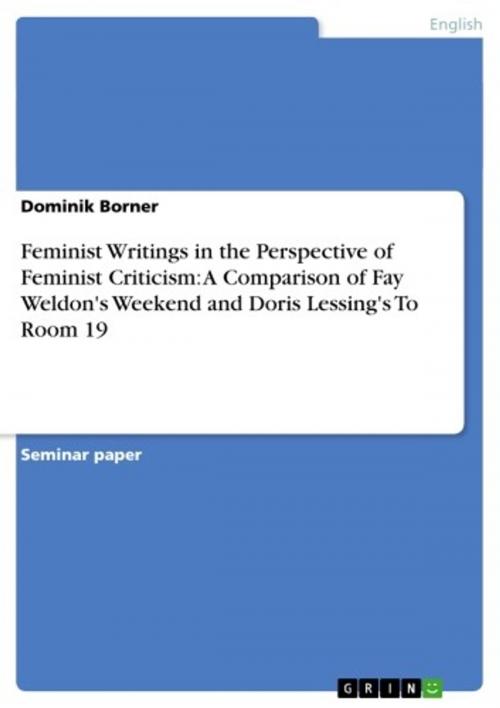Feminist Writings in the Perspective of Feminist Criticism: A Comparison of Fay Weldon's Weekend and Doris Lessing's To Room 19
Fiction & Literature, Literary Theory & Criticism, British| Author: | Dominik Borner | ISBN: | 9783638377751 |
| Publisher: | GRIN Publishing | Publication: | May 14, 2005 |
| Imprint: | GRIN Publishing | Language: | English |
| Author: | Dominik Borner |
| ISBN: | 9783638377751 |
| Publisher: | GRIN Publishing |
| Publication: | May 14, 2005 |
| Imprint: | GRIN Publishing |
| Language: | English |
Seminar paper from the year 2005 in the subject English Language and Literature Studies - Literature, grade: 1,3, University of Bamberg, course: Proseminar: Reading British Short Stories, 10 entries in the bibliography, language: English, abstract: 1. Introduction Early in the morning she rises, The Woman's work is never done. And it's not because she doesn't try, She's fighting a battle with no one on her side. She rises up in the morning, And she works 'til way past dusk. The woman better slow down, Or she's gonna come down hard. Early in the morning she rises, The woman's work is never done. Woman's Work, by Tracy Chapman (1992) 'Ah, to be all things to all people: children, husband, employer, friends! It can be done: yes, it can: super woman' (Weldon 1988, 312). The short stories Weekend by Fay Weldon and Doris Lessing's To Room 19 resemble each other in the aspect of presenting two female characters struggling in their lives under the pressure of the multiple roles they are to fulfill every day. But despite the superficial similarity of these stories, the two female authors chose different ways of pointing out the general themes of patriarchy and female entrapment to the reader. Feminist literary criticism covers a broad range of theories and politics and it is hard to define the one feminist approach, however one of the main goals of feminist critics has been to point out patriarchal structures , oppression of women and inequalities of power between men and women. While these themes are often implicitly hidden in male literature, Weldon and Lessing dramatize and display them explicitly in their short stories. In this paper, some of the aspects of feminist theory will be applied to focus on the author's different ways of presenting patriarchal structures by analyzing the similarities, but most importantly the differences in their respective settings and characters. To create a basis for discussion, in the following chapter an analysis of the female and male main characters will be connected with a deeper look at the general themes and motives that both short stories display. Subsequently, the third chapter will deal with the significant differences of the characters and the plots, leading into the question in which way the authors influence their readers and what effect on the reader each author may have desired.
Seminar paper from the year 2005 in the subject English Language and Literature Studies - Literature, grade: 1,3, University of Bamberg, course: Proseminar: Reading British Short Stories, 10 entries in the bibliography, language: English, abstract: 1. Introduction Early in the morning she rises, The Woman's work is never done. And it's not because she doesn't try, She's fighting a battle with no one on her side. She rises up in the morning, And she works 'til way past dusk. The woman better slow down, Or she's gonna come down hard. Early in the morning she rises, The woman's work is never done. Woman's Work, by Tracy Chapman (1992) 'Ah, to be all things to all people: children, husband, employer, friends! It can be done: yes, it can: super woman' (Weldon 1988, 312). The short stories Weekend by Fay Weldon and Doris Lessing's To Room 19 resemble each other in the aspect of presenting two female characters struggling in their lives under the pressure of the multiple roles they are to fulfill every day. But despite the superficial similarity of these stories, the two female authors chose different ways of pointing out the general themes of patriarchy and female entrapment to the reader. Feminist literary criticism covers a broad range of theories and politics and it is hard to define the one feminist approach, however one of the main goals of feminist critics has been to point out patriarchal structures , oppression of women and inequalities of power between men and women. While these themes are often implicitly hidden in male literature, Weldon and Lessing dramatize and display them explicitly in their short stories. In this paper, some of the aspects of feminist theory will be applied to focus on the author's different ways of presenting patriarchal structures by analyzing the similarities, but most importantly the differences in their respective settings and characters. To create a basis for discussion, in the following chapter an analysis of the female and male main characters will be connected with a deeper look at the general themes and motives that both short stories display. Subsequently, the third chapter will deal with the significant differences of the characters and the plots, leading into the question in which way the authors influence their readers and what effect on the reader each author may have desired.















